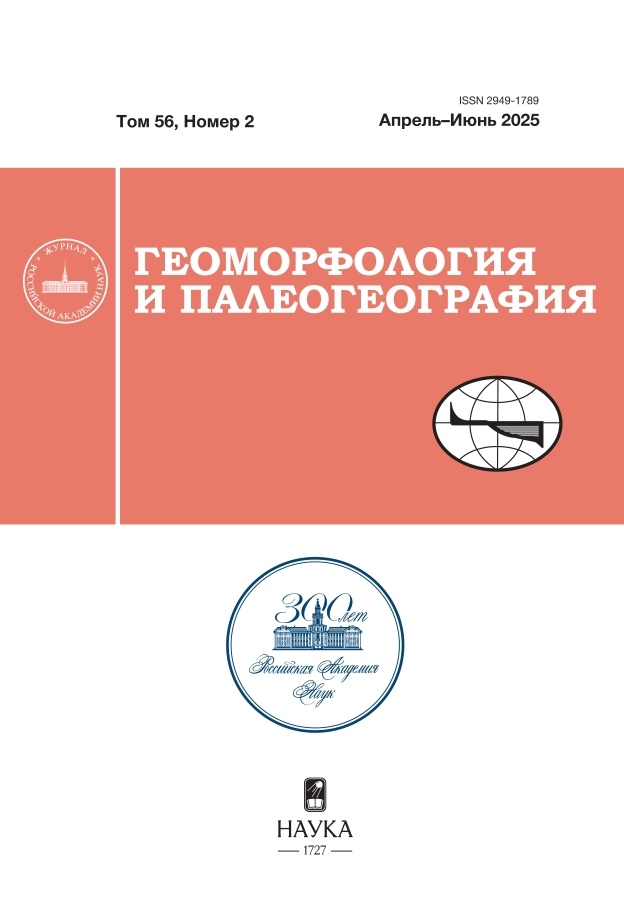Regularities of change for location density and size changes of thermal cirques of the abrasion shores within the cryolithozone based on remote sensing data
- Authors: Victorov A.S.1
-
Affiliations:
- Sergeev Institute of Environmental Geoscience of RAS
- Issue: Vol 56, No 2 (2025)
- Pages: 251-261
- Section: ГЕОМОРФОЛОГИЯ МОРСКИХ БЕРЕГОВ И ДНА
- URL: https://cijournal.ru/2949-1789/article/view/689283
- DOI: https://doi.org/10.31857/S2949178925020054
- EDN: https://elibrary.ru/GPVOCR
- ID: 689283
Cite item
Abstract
The aim of this research is to determine the changes through time of the quantitative parameters of the thermal cirques along the abrasive coasts within the cryolithozone. The analysis of the processes revealed two opposite trends; a decrease in the number of the thermal cirques along the cryolithozone coastlines due to replacement of the older thermal cirques with new ones, and an increase in their number due to the emergence of new ones within the existent forms. This increase results from their division and the display of the new thermal cirques. Based on the calculated average density and size of the thermal cirques the model predicted that under the homogeneous physical geographical conditions the average density of thermal cirques along the abrasive coasts within the cryolithozone should increase with time, while the average size should decrease. The local physical and geocryological conditions influence the values of the dependence parameters, but their relationship remains the same. An examination of the obtained dependence showed that with time, the density and average size of the thermal cirques tend to reach critical limiting values. At the same time the retreating coastal slope continue to change, new thermal cirques appear, and partial or complete disappearance of the existing ones occurs. Thus, after a significant period of development, the morphology of the abrasive coast may reach a state of dynamic equilibrium. Analysis of six abrasive coasts using repeated satellite imagery showed an increase in density and a decrease in average sizes of the thermal cirque along three of them, and an apparent stability of parameters along the other three coasts, which is in an agreement with the obtained modeling results. The obtained regularities should be used when forecasting the dynamics of the Arctic coasts based on satellite imagery.
Full Text
About the authors
A. S. Victorov
Sergeev Institute of Environmental Geoscience of RAS
Author for correspondence.
Email: vic_as@mail.ru
Russian Federation, Moscow
References
- Belova N.G., Shabanova N.N., Ogorodov S.A. et al. (2017) Erosion of permafrost coasts of Kara Sea near Kharasavey Cape, Western Yamal. Earth’s Cryosphere. Vol. 21. No. 6. P. 73–83. https://doi.org/10.21782/EC1560-7496-2017-6(73-83)
- Khomutov A.V., Leibman M.O. (2008) Landscape controls of thermodenudation rate change on Yugorsky Peninsula Coast. Kriosfera Zemli. Vol. XII. No. 4. P. 24–35 (in Russ).
- Kizyakov A.I. (2005) The dynamics of thermodenudation processes at the Yugorsky Peninsula coast. Kriosfera Zemli. Vol. IX. No. 1. P. 63–67 (in Russ).
- Leibman M., Kizyakov А., Zhdanova Y. et al. (2021) Coastal Retreat Due to Thermodenudation on the Yugorsky Peninsula, Russia during the Last Decade, Update since 2001–2010. Remote Sens. Vol. 13. Iss. 20. 4042. https://doi.org/10.3390/rs13204042
- Nesterova N.B., Khomutov A.V., Leibman M.O. et al. (2021) Inventory of retrogressive thaw slumps (thermocirques) in the north of West Siberia based on 2016–2018 satellite imagery mosaic. Kriosfera Zemli. Vol. XXV. 6. P. 34–41 (in Russ).
- Novikova A.V. (2022) Morfologiya i dinamika termoabrazionnykh beregov Karskogo morya (Morphology and dynamics of thermal abrasion coasts of the Kara Sea). PhD thesis. Moscow: MGU. 26 p. (in Russ.).
- Ogorodov S.A., Arkhipov V.V., Baranskaya A.V. et al. (2014) Technogenic factor of the dynamics of the coasts of the Pechora and Kara Seas in the context of climate change and ice cover. In: Materialy XXV Mezhdunarodnoy beregovoy konferentsii “Beregovaya zona – vzglyad v budushcheye”. Moscow: GEOS (Publ.). P. 114–117 (in Russ).
- Pizhankova E.I., Dobrynina M.S. (2010) The dynamics of the Lyakhovsky Islands coastline (results of aerospace image interpretation). Kriosfera Zemli. Vol. XIV. No. 4. P. 66–79 (in Russ).
- Pizhankova E.I. (2011) Termodenudation in the coastal zone of the Lyakhovsky Islands (interpretation of aerospace images). Kriosfera Zemli. Vol. XV. No. 3. P. 61–70 (in Russ).
- Sovershayev V.A. (1998) Cryogenic processes and phenomena on the coast and shelf of the Arctic seas. In: Dinamika arkticheskikh poberezhii Rossii. Moscow: MGU (Publ.). P. 12–18 (in Russ).
- Vasiliev A.A., Pokrovsky S.I., Shur Yu.L. (2001) Dynamics of thе coastal thermoerosion of West Yamal. Kriosfera Zemli. Vol. V. No. 1. P. 44–52 (in Russ).
- Victorov A.S., Orlov T.V., Arkhipova M.V. et al. (2023) Quantitative laws of a morpological pattern for abrasion slopes witn a landslide process within the cryolithozone (the coasts of the Kanin and Yamal Peninsulas as examples. Geomorfologiya i Paleogeografiya. Vol. 54. No. 3. P. 124–137 (in Russ). https://doi.org/10.31857/S294917892303012X
Supplementary files














